
If this is showing on the site, the Archived items aren't filtering out.
- Subject:
- History
- Material Type:
- Lesson Plan
- Author:
- National Air and Space Museum
- Date Added:
- 06/14/2022

If this is showing on the site, the Archived items aren't filtering out.
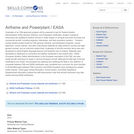
Graduates of an FAA-approved program will be prepared to test for Federal Aviation Administration (FAA) General, Airframe, and Powerplant certificates. Aviation maintence technicians are qualified to perform service or make repairs on all types and sizes of private and commercial aircraft, including airplanes, helicopters, and their propulsion systems.
Contents include student project books for FAA general, airframe, and powerplant programs, course objectives, course outlines, and other instructional materials for eight airframe courses and eight general courses, and an instructor project book. A glossary of aircraft mechanic terms was also developed to assist English language learners and students new to aviation. Materials were developed to implement on computers and tablets maintained in the aviation labs.
EASA (European Aviation Safety Administration) is the European equivalent of the FAA, and also certify aircraft mechanics to repair or service European aircraft. Although the skill sets of the two certifications are similar, the processes for attaining and certifying the skills is very different. A crosswalk between FAA and EASA certification was completed and curriculum for short modules to fill identified gaps between FAA curriculum and EASA standards were developed by subject matter experts. These gaps include fiberoptics, human factors, and EASA regulations. Supplemental information outlines the self-improvement route that aircraft mechanics may take toward earning EASA certification.
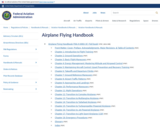
The Airplane Flying Handbook provides basic knowledge that is essential for pilots. This handbook introduces basic pilot skills and knowledge that are essential for piloting airplanes. It provides information on transition to other airplanes and the operation of various airplane systems. It is developed by the Flight Standards Service, Airman Testing Standards Branch, in cooperation with various aviation educators and industry. This handbook is developed to assist student pilots learning to fly airplanes. It is also beneficial to pilots who wish to improve their flying proficiency and aeronautical knowledge, those pilots preparing for additional certificates or ratings, and flight instructors engaged in the instruction of both student and certificated pilots. It introduces the future pilot to the realm of flight and provides information and guidance in the performance of procedures and maneuvers required for pilot certification.
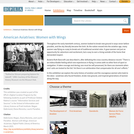
Throughout the early twentieth century, women looked to break new ground in ways never before possible, and the sky literally became the limit. As the nation moved into the aviation age, many women saw flying as a way to break out of traditional societal roles. It gave women not just an opportunity for adventure and excitement, but a way to earn a living outside of the home that demanded respect. Aviatrix Ruth Bancroft Law described it, after defeating the cross-country distance record: "There is an indescribable feeling which one experiences in flying; it comes with no other form of sport or navigation. It takes courage and daring; one must be self-possessed, for there are moments when one's wits are tested to the full. Yet there is an exhilaration that compensates for all one's efforts." In this exhibition we explore the early history of aviation and the courageous women who took to the skiesaviatrixes who found freedom, broke new ground, and inspired generations of women along the way. This exhibition was created as part of the DPLAs Digital Curation Program by the following students as part of Professor Debbie Rabinas course "Information Services and Sources" in the School of Information and Library Science at Pratt Institute: Megan DeArmond, Diana Moronta, Laurin Paradise.
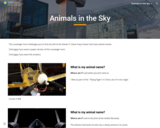
This digital scavenger hunt challenges you to find aircraft at the Steven F. Udvar-Hazy Center that have animal names.

This paper version of our popular scavenger hunt challenges you to find aircraft at the Steven F. Udvar-Hazy Center that have animal names.
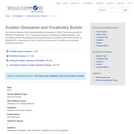
The Aviation Glossary and Vocabulary Builder is composed of 1900+ FAA terms primarily for Airframe & Powerplant. This is composed of simple non-technical, English definitions. The Vocabulary Builder was designed to use an inexpensive, proprietary online format known as WordWeb Pro. Instructions on how to load the vocabulary into WordWeb and a printable glossary are included.

The Aviation Maintenance Technician Handbook—Airframe (FAA-H-8083-31B) is one of a series of three handbooks for persons preparing for certification as an airframe or powerplant mechanic. This handbook provides basic information on principles, fundamentals, and technical procedures in the subject matter areas relating to the airframe rating. It is designed to aid students enrolled in a formal course of instruction, as well as the individual who is studying on their own. Since the knowledge requirements for the airframe and powerplant ratings closely parallel each other in some subject areas, the chapters which discuss fire protection systems and electrical systems contain some material which is also duplicated in the Aviation Maintenance Technician Handbook—Powerplant (FAA-H-8083-32B). This handbook contains information on airframe construction features, assembly and rigging, fabric covering, structural repairs, and aircraft welding. The handbook also contains an explanation of the units that make up the various airframe systems. Because there are so many different types of aircraft in use today, it is reasonable to expect that differences exist in airframe components and systems. To avoid undue repetition, the practice of using representative systems and units is carried out throughout the handbook. Subject matter treatment is from a generalized point of view and should be supplemented by reference to manufacturers’ manuals or other textbooks if more detail is desired. This handbook is not intended to replace, substitute for, or supersede official regulations or manufacturers’ instructions. Occasionally the word “must” or similar language is used where the desired action is deemed critical. The use of such language is not intended to add to, interpret, or relieve a duty imposed by Title 14 of the Code of Federal Regulations (14 CFR).

This handbook describes the United States (U.S.) aviation weather program, products, and services. It also documents weather theory and its application to aviation. The objective of this handbook is to help the pilot and operator understand the basics of weather, aviation weather hazards, and aviation weather products. The information included is not prescriptive. Furthermore, the guidance and recommendations in this handbook are not legally binding in their own right and will not be relied upon by the FAA as a separate basis for affirmative enforcement action or other administrative penalty. Conformity with the guidance and recommendations is voluntary only and nonconformity will not affect rights and obligations under existing statutes and regulations.

Born to poor sharecroppers in Texas, Bessie Coleman (1892-1926) was the first African American woman aviator, earning an international aviation license from the Fédération Aéronautique Internationale. Throughout her career as a daredevil stunt pilot in thrilling airshows, she consistently defied expectations and broke through racial and gender barriers to dazzle audiences and inspire future generations of Black American pilots, aviators, and astronauts. This lesson tells the story of Coleman’s life in the wider context of the “barnstorming” early days of flight and the rising opposition to racial segregation exemplified by newspapers like the Chicago Defender.
The Woodson Center's Black History and Excellence curriculum is based on the Woodson Principles and tells the stories of Black Americans whose tenacity and resilience enabled them to overcome adversity and make invaluable contributions to our country. It also teaches character and decision-making skills that equip students to take charge of their futures. These lessons in Black American excellence are free and publicly available for all.

This lesson provides an overview of the world's first African American female pilot, who overcame multiple barriers (racial, gender-based, historical, socioeconomic) in order to become a celebrated aviator and daredevil performer who thrilled both Black and White audiences. It is suitable for a lesson in history class, and would makean enriching addition to courses dealing with technical or scientific fields connected with aviation. The Woodson Center’s K-12 black history and character curriculum is based on the Woodson Principles and tells the stories of black Americans whose tenacity and resilience enabled them to overcome adversity and make invaluable contributions to our country. It also teaches character and decision-making skills that equip students to take charge of their futures. These lessons in black American excellence are free and publicly available for all.
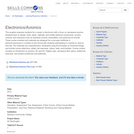
This program prepares students for a career in electronics with a focus on aerospace avionics. Students learn to design, build, repair, calibrate, and modify electrical components, circuitry controls, and machinery such as industrial controls, transmitters, and antennas for aircraft.
These course modules and materials are designed for a one-year certificate in electronics/avionics in a hybrid on-line format with students participating in a hands-on, face-to-face lab. The materials are comprehensive, developed using the principles of Universal Design, and include course objectives, syllabi, lab exercises, videos, tests, and booklets. Course content includes an introduction to avionics, AC and DC, Digital Logic, aerospace fiber optics, related lab exercises, and student workbooks and textbooks.

During World War II, thousands of Black Americans joined the Navy, ready to serve their country. But deep-seated prejudice prevented Black sailors from rising in the ranks, and never in its history had the Navy commissioned Black officers. This is the story of the men who broke that barrier and became the first class of African American officers in the United States Navy, overcoming skepticism and hostility at every turn. Their skill, resilience, and character propelled them to great success in postwar life, and paved the way for today’s diverse armed forces.
The Woodson Center's Black History and Excellence curriculum is based on the Woodson Principles and tells the stories of Black Americans whose tenacity and resilience enabled them to overcome adversity and make invaluable contributions to our country. It also teaches character and decision-making skills that equip students to take charge of their futures. These lessons in Black American excellence are free and publicly available for all.

During World War II, thousands of Black Americans joined the Navy, ready to serve their country. But deep-seated prejudice prevented Black sailors from rising in the ranks, and never in its history had the Navy commissioned Black officers. This is the story of the men who broke that barrier and became the first class of African American officers in the United States Navy, overcoming skepticism and hostility at every turn. Their skill, resilience, and character propelled them to great success in postwar life, and paved the way for today’s diverse armed forces. The Woodson Center's Black History and Excellence curriculum is based on the Woodson Principles and tells the stories of Black Americans whose tenacity and resilience enabled them to overcome adversity and make invaluable contributions to our country. It also teaches character and decision-making skills that equip students to take charge of their futures. These lessons in Black American excellence are free and publicly available for all.
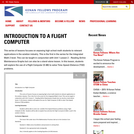
This series of lessons focuses on exposing high school math students to relevant applications in the aviation industry. This is the first in the series for the Integrated Math 2 level. This can be taught in conjunction with Unit 1 Lesson 2 Reading Airline Maintenance Graphs but can also be a stand-alone lesson. In this lesson, students will explore the use of a Flight Computer (E-6B) to solve Time-Speed-Distance (TSD) problems.
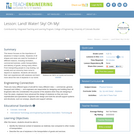
This lesson focuses on the importance of airplanes in today's society. Airplanes of all shapes and sizes are used for hundreds of different reasons, including recreation, commercial business, public transportation, and delivery of goods, among many others. From transporting people to crop-dusting, our society and our economy have come to depend on airplanes. Students will discuss their own experiences with airplanes and learn more about the role of airplanes in our world.

This example shows how Newton's laws of motion apply to aircraft carriers and introduces the lift equation: the amount of lift depends on the air density, the wind velocity, and the surface area of the wings. The problems stress the importance of units of measure. This resource is from PUMAS - Practical Uses of Math and Science - a collection of brief examples created by scientists and engineers showing how math and science topics taught in K-12 classes have real world applications.

The purpose of this activity is to demonstrate how aircrafts have decreased the amount of time it takes to transport people and cargo. Students will compute the time it takes to travel between two cities for several modes of transportation including trucks, trains and airplanes. Students will also do some critical thinking to determine why airplanes are not always used.

Meet Shaesta Waiz. She's a young, female pilot who's making a solo trip around the world. Find out what inspires her and what advice she has for middle school students.

"Find your passion," says veteran Astronaut Peggy Whitson. The Iowa native holds the record for time in space by an American. Learn all about Whitson in this episode of My Path.